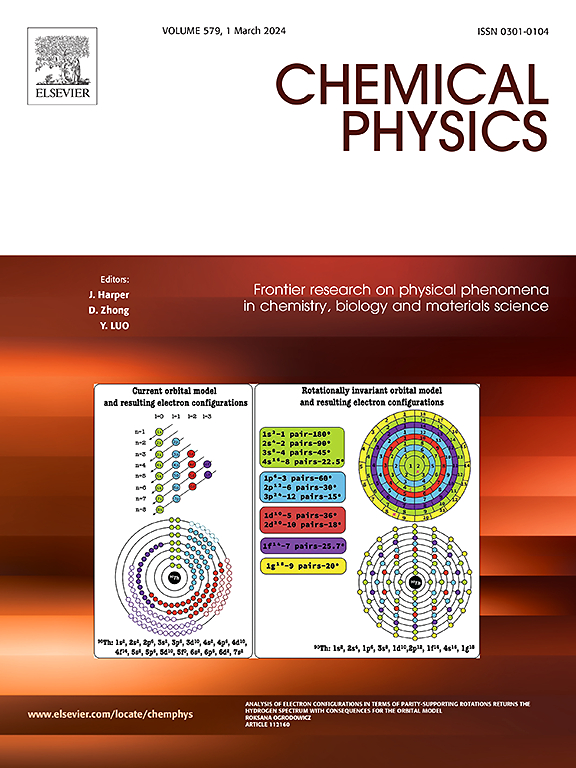TM-G-N4轴向配位非金属催化CO2转化为HCOOH的活性和选择性
IF 2
3区 化学
Q4 CHEMISTRY, PHYSICAL
引用次数: 0
摘要
电催化CO2还原反应(CO2RR)是解决能源危机和温室效应的有效策略。然而,CO2RR的效率仍然不足以用于工业应用。为了提高CO2RR的效率,需要开发合适的电催化剂。过渡金属与氮掺杂石墨烯配位(TMN4@G)结合轴向配位工程的独特优势,是催化CO2RR的有前途的方法。在本研究中,通过密度泛函理论(DFT)计算系统地评价了TMN4@G (TM = Co, Ni和Cu)与不同轴向配体(TMN4-L@G, L = B, N, P, O, S, F, Cl, Br, I和OH)的CO2RR性能。结果表明,轴向配体对TMN4@G的CO2RR有不同程度的影响。CuN4-N@G和CuN4-P@G在TMN4-L@G中通过P2通路机制(还原成HCOOH)表现出优异的竞争性HER抑制能力,对应的电位极限(UL)分别为−0.16 V和−0.11 V。预测CO2分子在CuN4-N@G和CuN4-P@G上被物理吸附,加氢后的中间体在两种催化剂表面被化学吸附,这表明轴向配位工程可以通过调节CuN4-N@G和CuN4-P@G的电荷分布来提高中间体的吸附稳定性。此外,态密度(DOS)和电荷密度差分析表明,引入轴向非金属原子可以增强中间体吸附能力,提高CO2转化为HCOOH的活性。同时,d波段中心、功函数和ICOHP结果表明,轴向配体可以调节CuN4@G的电子结构,提高其表面CO2RR催化活性。从头算分子动力学(AIMD)模拟验证了CuN4-N@G和CuN4-P@G在反应温度下是动态稳定的。该研究为轴向配位石墨烯上CO2电催化还原的机理提供了新的见解。本文章由计算机程序翻译,如有差异,请以英文原文为准。
The activity and selectivity in CO2 to HCOOH conversion on TM-G-N4 with axially coordinated nonmetal
Electrocatalytic CO2 reduction reaction (CO2RR) is an effective strategy to address the energy crisis and the greenhouse effect. However, the efficiency of CO2RR is still insufficient for industrial applications. It is needed to develop suitable electrocatalysts to increase efficiency of CO2RR. The transition metal coordinated with nitrogen doped graphene (TMN4@G) combined with the unique advantages of axial coordination engineering are the promising methods for catalytic CO2RR. In this study, the CO2RR performance of TMN4@G (TM = Co, Ni, and Cu) with various axial ligands (TMN4-L@G, L = B, N, P, O, S, F, Cl, Br, I, and OH) is systematically evaluated by density functional theory (DFT) calculations. The results indicate that axial ligands have different degree of effect on the CO2RR of TMN4@G. CuN4-N@G and CuN4-P@G display excellent suppression ability of competitive HER via P2 pathway mechanism (reduction into HCOOH) among TMN4-L@G, with the corresponding potential limiting (UL) are −0.16 and − 0.11 V, respectively. CO2 molecule is predicted physically adsorbed on CuN4-N@G and CuN4-P@G, while following hydrogenation intermediates is chemisorbed on these two catalysts surface, which indicates that axial coordination engineering can improve the adsorption stability of intermediates by regulating the electric charge distribution of the CuN4-N@G and CuN4-P@G. Moreover, density of states (DOS) and charge density difference analysis indicate that the introduced axial nonmetal atoms can enhance intermediates adsorption ability and improve the activity of CO2 conversion into HCOOH. Meanwhile, the d-band center, work function, and ICOHP results reflect that the axial ligands can modulate electronic structures of CuN4@G and improve its surface CO2RR catalytic activity. The ab initio molecular dynamics (AIMD) simulations verified that CuN4-N@G and CuN4-P@G are dynamically stabilized at the reaction temperature. This study offers novel insight into the mechanism of CO2 electrocatalytic reduction on axially coordinated graphene.
求助全文
通过发布文献求助,成功后即可免费获取论文全文。
去求助
来源期刊

Chemical Physics
化学-物理:原子、分子和化学物理
CiteScore
4.60
自引率
4.30%
发文量
278
审稿时长
39 days
期刊介绍:
Chemical Physics publishes experimental and theoretical papers on all aspects of chemical physics. In this journal, experiments are related to theory, and in turn theoretical papers are related to present or future experiments. Subjects covered include: spectroscopy and molecular structure, interacting systems, relaxation phenomena, biological systems, materials, fundamental problems in molecular reactivity, molecular quantum theory and statistical mechanics. Computational chemistry studies of routine character are not appropriate for this journal.
 求助内容:
求助内容: 应助结果提醒方式:
应助结果提醒方式:


